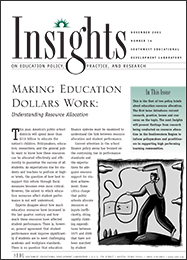References & Credits
- Achilles, C. (1999). Let's put kids first: Finally getting class size right.Thousand Oaks, CA: Corwin Press.
- Alexander, C.D., Boyer, H., Brownson, A.B., Clark, C., Jennings, J., & Patrick, E.S. (2000). Resource allocation practices and student achievement: An examination of district expenditures by performance level with interviews from twenty-one school districts.Austin, TX: The Charles A. Dana Center at The University of Texas at Austin and the Southwest Educational Development Laboratory.
- Chambers, J. (1999). Measuring resources in education: From accounting to the resource cost model approach.Washington, DC: U.S. Department of Education, Office of Educational Research and Improvement.
- Class Size Reduction Research Consortium. (2000). Small classes and large issues: The 1998-99 evaluation of class size reduction in California.Retrieved August 6, 2001, from http://www.classize.org/summary/98-99/index.htm.
- Cohen, D.K., Raudenbush, S.W, & Ball, D.L. (2000). Resources, instruction, and research.Seattle, WA: Center for the Study of Teaching and Policy at the University of Washington.
- Coleman, J.S., Campbell, E.Q., Hobson, C.J., McPartland, J., Mood, A.M., Weinfeld, F.D., & York, R.L. (1966). Equality of educational opportunity.Washington, DC: U.S. Government Printing Office.
- Hanushek, E.A. (1986). The economics of schooling: Production and efficiency in public schools. Journal of Economic Literature, 24(3), 1141-1177.
- Hanushek, E.A. (1996). School resources and student performance. In G. Burtless (ed.), Does money matter? The effect of school resources on student achievement and adult success(pp. 43-73). Washington, DC: Brookings Institution Press.
- Hanushek, E.A. (1997). Assessing the effects of school resources on student performance: An update. Educational Evaluation and Policy Analysis, 19(2), 141-164.
- Hedges, L.V. & Greenwald, R. (1996). Have times changed? The relation between school resources and student performance. In G. Burtless (ed.), Does money matter? The effect of school resources on student achievement and adult success(pp. 74-92). Washington, DC: Brookings Institution Press.
- Hedges, L.V., Laine, R.D., & Greenwald, R. (1994). Does money matter? A meta-analysis of studies of the effects of differential school inputs on student outcomes. Educational Researcher, 23(3), 5-14.
- Levin, H.M. & McEwan, P.J. (2001). Cost-effectiveness analysis (2nd ed.). Thousand Oaks, CA: Sage Publications.
- National Center for Education Statistics. (1998). Digest of education statistics, 1997, Table 82.Washington, DC: U.S. Department of Education.
- National Center for Education Statistics. (2001). Digest of education statistics, 2000, Table 164.Washington, DC: U.S. Department of Education.
- Odden, A. (2000). Uses of the educational dollar: Expenditure patterns. Madison, WI: Consortium for Policy Research in Education, University of Wisconsin Madison.
- Odden, A. & Archibald, S. (2001). Reallocating resources: How to boost student achievement without asking for more.Thousand Oaks, CA: Corwin Press.
- Picus, L.O. (2001). In search of more productive schools: A guide to resource allocation in education. Eugene, OR: ERIC Clearinghouse on Educational Management, University of Oregon.
- Rothstein, R. (1997). Where's the money going? Changes in the level and composition of education spending, 1991-96. Washington, DC: Economic Policy Institute.
Credits
Authors: Catherine Clark, Heather Boyer, and Celeste Alexander from the Charles A. Dana Center at The University of Texas at Austin, and Zena Rudo and Diane Pan from SEDL
Content Reviewers: Sharon Ball from the University of New Mexico; Keith Clark from Aldine ISD; Joan Buttram, Ed Tobia, and Sebatian Wren from SEDL; and Janice Bradley from the Charles A. Dana Center
Copy Editor: Johanna Franke from SEDL
Design and Layout: David Timmons.
Online Design and Layout: Shaila Abdullah
Insights on Education Policy, Practice, and Researchmay be reproduced and copies distributed to members by educational agencies, organizations, and associations.
| This publication is based on work sponsored wholly, or in part, by the Office of Educational Research and Improvement, U.S. Department of Education, under Contract #ED01CO009. The contents of this publication do not necessarily reflect the views of OERI, the Department, or any other agency of the U.S. Government. SEDL||OERI Southwest Educational Development Laboratory |

